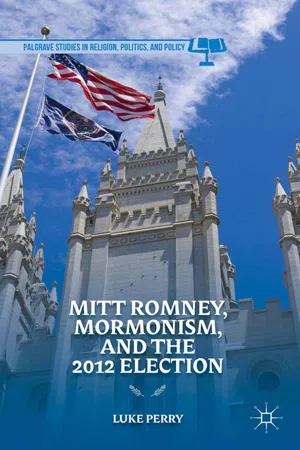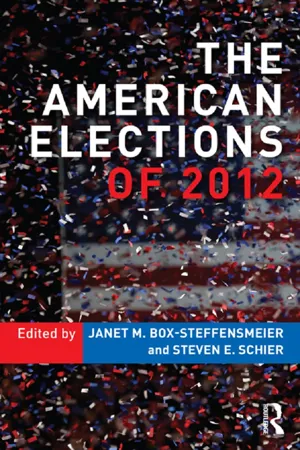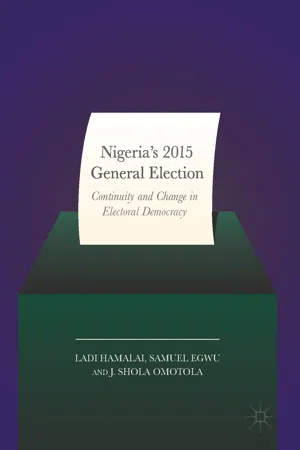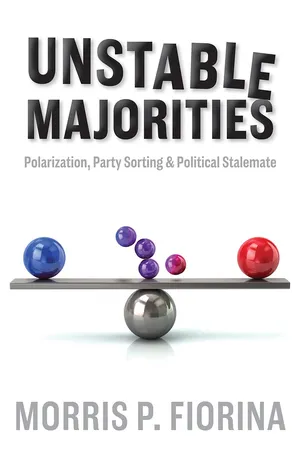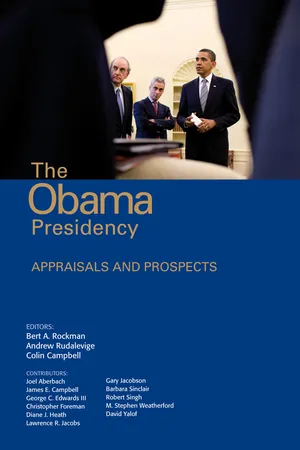History
2012 Presidential Election
The 2012 Presidential Election in the United States saw incumbent President Barack Obama, a Democrat, win re-election against Republican candidate Mitt Romney. The election was marked by debates on economic policies, healthcare, and foreign affairs. President Obama secured a second term in office, while the election highlighted the country's political divisions and the importance of swing states in the electoral process.
Written by Perlego with AI-assistance
Related key terms
1 of 5
6 Key excerpts on "2012 Presidential Election"
- eBook - ePub
- L. Perry(Author)
- 2014(Publication Date)
- Palgrave Macmillan(Publisher)
1 Introducing the 2012 Presidential ElectionThe 2012 election was extraordinary in several ways even though the balance of power remained unchanged. President Barack Obama faced unprecedented economic woes despite having a remarkably active first term. The Republican field experienced the meteoric rise of multiple long-shot candidates before aligning behind an unlikely front-runner, Mitt Romney. It was a particularly long and publicized primary process modeled in part after the bruising 2008 Democratic primary that was believed to strengthen the political chops of the Democratic savior that emerged and his potential successor in 2016. The 2012 primary did not have the same effect for Republicans. Romney emerged weakened by internal and external attacks, not to mention, “the Mormon thing,” as Romney called it.Romney is a devout member of The Church of Jesus Christ of Latter-day Saints (LDS Church). His family lineage is intertwined with the history of the church. His friends and colleagues assert that he would have been among the most religious presidents in US history. Much of this part of his life was deliberately kept out of the public eye because of nearly two centuries of Mormon persecution, intolerance, and misunderstanding that inhibited his candidacy. Undoubtedly Romney’s nomination was one of the most significant events in American politics and religion in the modern era. This book provides a comprehensive analysis of this important event.The candidatesBarack Obama and Mitt Romney faced two different political climates in running for president. Obama was swept into office in 2008 under the banner of “change,” his campaign slogan that demonstrated acute understanding of what was on the minds of most Americans. George W. Bush left office as one of the least popular presidents in US history. Osama Bin Laden was at large. There were no weapons of mass destruction in Iraq. Neither Afghanistan, nor Iraq, was stable or democratic despite extraordinary human and financial costs. The federal government woefully underresponded to Hurricane Katrina. And worst of all, the economy was unraveling in a manner that rivaled the Great Depression. Republican candidate John McCain did not appear up to the task of solving these problems or providing a new direction for the country. His “maverick” days as an upstart senator were ancient history. The political climate was ripe for a Democratic rising star to break the racial barrier to the presidency. - eBook - ePub
- Janet M. Box-Steffensmeier, Steven E. Schier(Authors)
- 2013(Publication Date)
- Routledge(Publisher)
10 The Reaffirmation of the Post– Cold War Electoral OrderThe Meaning of the 2012 ElectionNicol C. RaeSince the end of the Cold War and the election of Bill Clinton to the presidency in 1992, the United States has experienced an era of highly competitive and close national elections between increasingly ideologically polarized national political parties (Theriault and Moeller 2013). This development is based on post–New Deal electoral alignments along racialethnic/cultural/religious lines (Layman 2001) and reinforced by clusters of “policy demanding” interests around each of the major parties (Cohen et al. 2008); by ideological networks of campaign contributors, grassroots activists, media, and think tanks (Fiorina 2006, 2009); and by the advent of new political media—cable news, talk radio, the Internet/blogs—that encourage political “narrowcasting” (Sunstein 2007). All of this has increased the costs of crossing party lines in Washington, DC, on any issue and has made the compromises needed to advance legislation in America’s separated system of government much harder to achieve (except, perhaps, in the few months following the election of a new president). One result is wider public exasperation with “gridlock” and “political dysfunction” in the U.S. federal government (Brownstein 2008).During the two decades between Bill Clinton’s first inauguration and the second inauguration of Barack Obama, the Democrats controlled the presidency for 12 years to the Republicans’ 8 years; the Republicans controlled the U.S. House of Representatives for 14 years to the Democrats’ 6 years; and control of the U.S. Senate has been held by each party for 10 years in total. Elections during the period for both president and Congress were closely contested, although there appears to be a slight Democratic advantage in presidential elections and a slight Republican advantage in House elections, with Senate elections very evenly balanced. - eBook - PDF
Nigeria's 2015 General Elections
Continuity and Change in Electoral Democracy
- Ladi Hamalai, Samuel Egwu, J. Shola Omotola(Authors)
- 2017(Publication Date)
- Palgrave Macmillan(Publisher)
CHAPTER 10 The 2015 Presidential Election INTRODUCTION This chapter focuses on the 2015 presidential election. Although some of the issues involved have been partially highlighted in earlier chapters, focusing on them separately gives the benefits of in-depth examinations of the salient issues underlying the presidential election. This is the pri- mary purpose of this chapter, the aim of which is to critically examine the conduct of the 2015 presidential election, with a view to identifying its high and low points. Pursuant to this goal, the chapter addresses, first and foremost, why the 2015 presidential election matters. In the second sec- tion, the chapter examines salient issues in the presidential election, namely party primaries and candidates selection, with emphasis on the two leading political parties, the PDP and APC, electioneering campaigns, election administration and election integrity, voting patterns and election results, as well as post-election reactions. Across these subsections, we reflected on important ethno-regional and religious forces as intervening variables in the voting pattern. We also underscored the key factors in the improved administration and integrity of the election, and accounts for the success and failure of the winning and losing candidates/parties using the same explanatory themes. The analyses that run through these themes reinforced that despite noticeable gaps in certain aspects, the 2015 pre- sidential election seemed more effectively administered, resulting in dee- per democratic qualities of competition, participation and legitimacy. We drew on the reports of both local and international election observers © The Author(s) 2017 L. Hamalai et al., Nigeria’s 2015 General Elections, DOI 10.1007/978-3-319-54096-2_10 203 - eBook - ePub
Unstable Majorities
Polarization, Party Sorting, and Political Stalemate
- Morris P. Fiorina(Author)
- 2017(Publication Date)
- Hoover Institution Press(Publisher)
CHAPTER 10 The 2016 Presidential Election—An Abundance of ControversiesEven by the colorful standards of presidential primaries, the 2016 election cycle has been filled with jaw-dropping, head-scratching moments .—Eric BradnerWhile the world celebrates and commiserates a Donald Trump presidency, one thing is clear: this will go down as the most acrimonious presidential campaign of all .—Rachel ReveszControversial presidential elections are nothing new in American electoral history, 2016 being the latest, but certainly not the first. Despite much apocalyptic commentary, however, the implications of the 2016 election seem less dire than those of some elections held in earlier eras. The four-candidate 1860 election started the country on the path to civil war and the disputed election of 1876 threatened to reignite that conflict. In more recent times, the strong showing of a racist third party in 1968 coupled with political assassinations and civil disorders on a scale not seen since the labor violence of the early twentieth century led some contemporary observers to believe that the country was “coming apart.”1 The 2000 Florida electoral vote contest raged for more than two months, threatening a constitutional crisis and deeply dividing partisan activists on both sides. Still, even allowing for the fact that secession and revolution are not seriously on the table, for the sheer number and breadth of the controversies that accompanied it, the 2016 election does seem out of the ordinary.Parties have nominated flawed candidates before—Republican Barry Goldwater in 1964 and Democrat George McGovern in 1972, for example—but at least since the advent of scientific survey research, no major party has nominated a candidate so wanting in the eyes of the electorate, let alone both doing so simultaneously. Charges of ethnocentrism and racism are as American as apple pie, but in their prevalence and virulence in 2016 (with misogyny added to the toxic mix) they were reminiscent of 1928, if not the late nineteenth century.2 “Biased media” is a complaint common to all elections, but the retreat from objectivity by the mainstream media in 2016 struck many observers as a significant break with modern journalistic practices.3 The increasingly visible role of social media like Twitter threatened to further diminish the importance of the legacy media. Swing voters, largely missing in action in recent elections, suddenly reappeared in 2016.4 Possible foreign intervention in the election was a new development (at least insofar as the United States was the intervenee rather than the intervener), as was FBI involvement (but possibly only because earlier instances did not become public). Meanwhile journalists scrambled to read up on “populism,” which had not played such a significant role in American elections since the 1960s. “Class,” long ago displaced by discussions of race, ethnicity, gender, and sexual orientation in college course syllabi, enjoyed an academic as well as political revival (so did “authoritarianism,” another oldie but goodie).5 - No longer available |Learn more
- Stephen Wayne(Author)
- 2019(Publication Date)
- Cengage Learning EMEA(Publisher)
Nonetheless, the popular vote was close and the red state–blue state division per-sisted. Only three states—Iowa, New Hampshire, and New Mexico—switched colors between 2000 and 2004. After the election, the Bush administration ran into trouble. The president’s domestic initiative to privatize Social Security failed; his administration’s response to Hurricane Katrina was late and inadequate; public opinion turned against the war in Iraq; and the economy was faltering and the budget deficit was rising. There was a major financial crisis in mid-September 2008. The president’s approval rat-ings dropped dramatically. On election day, 72 percent of the population disap-proved of the job Bush was doing. Beginning in 2006 and continuing through 2008, a majority of Americans believed that the Democrats would do better than the Republicans in keeping the country prosperous. Democratic partisans increased by 3 percent during this period; the Republican base declined while a larger proportion of the population identified themselves as Independents. 40 All of these factors helped the Democrats. The grassroots support Obama was able to muster, the large war chest he had raised, and the more disciplined, thematic campaign he mounted led to his large electoral victory. Obama won 52.9 percent of the popular vote and 67.8 percent of the electoral vote. Although the 2008 election was described as historic because the first African American was elected president, trends evident in past elections persisted. Partisan and ideological voting patterns remained; so did the gender gap with the voting differences between men and women at 13 percent. The secular-sectarian divide continued as did the distinctive voting patterns of different age groups. There was one major change, however. The composition of the electoral major-ity shifted from red to blue. The only competitive battleground state that Obama Copyright 2020 Cengage Learning. - eBook - PDF
The Obama Presidency
Appraisals and Prospects
- Bert A. Rockman, Andrew Rudalevige, Colin Campbell, Bert A. Rockman, Andrew C. Rudalevige, Colin Campbell(Authors)
- 2011(Publication Date)
- CQ Press(Publisher)
The first set encompassed the long-term political predispositions of the voters. Americans in 2008 were highly polarized, very partisan, and quite evenly divided in their perspectives on politics. Normally, this would be an overriding consideration in the election, and though it was important, it was superseded by a second set of important conditions in the election: evaluations of the departing administration. Though America was nearly a 50 -50 nation in its long-term political orientations, it was more like a “two-thirds to one-third” nation in its evaluation of the Bush presidency going into the 2008 election season. 17 Normally, this might have been the end of the story, but not in 2008 . Retrospective evaluations of the Bush presidency meant only so much in an open seat contest with an unusually moderate Republican candidate in Arizona senator John McCain. In the end, both the balance of long-term political predispositions and the negative pre-campaign retrospective evaluations of President Bush’s job performance were trumped by the third set of critical electoral forces: the financial crisis that became known as the Wall Street Meltdown. In mid-September of 2008 , it sent the economy spiraling into 74 james e. campbell a deep recession, the worst economic crisis since the Great Depression of the 1930 s, and sent Democratic presidential candidate Barack Obama to the White House. A Polarized and Partisan Nation. The electorate that Barack Obama and John McCain faced in their 2008 election was highly polarized. It had been so for many years, but became even more so in the early 1990 s. 18 Figure 4 . 1 presents the percentages of reported voters in the American National Election Study (ANES) who were moderates, conservatives, and liberals. Both self-described moderates and those who said that they did not know how to classify themselves ideologically are counted as moderates.
Index pages curate the most relevant extracts from our library of academic textbooks. They’ve been created using an in-house natural language model (NLM), each adding context and meaning to key research topics.
